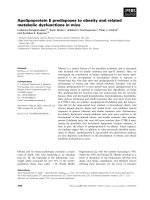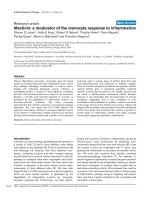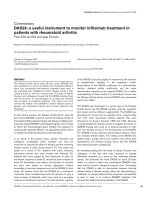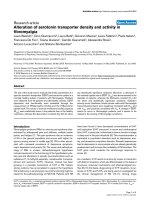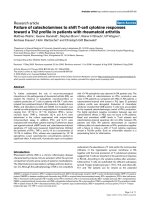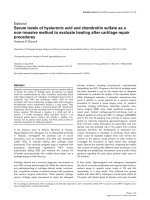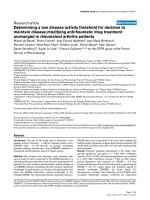Báo cáo y học: "Teach a man to fish and you feed him for a lifetime: physics, pharmacology and physiology for anaesthetists" pptx
Bạn đang xem bản rút gọn của tài liệu. Xem và tải ngay bản đầy đủ của tài liệu tại đây (123.34 KB, 1 trang )
Available online />The sheer depth and breadth of knowledge required for the
Fellow of the Royal College of Anaesthetists examinations in
anaesthesia is compelling. This is particularly true with
regards to the basic science components with which you
have to be familiar during a challenging viva or multiple choice
question examination.
In their book Physics, Pharmacology and Physiology for
Anaesthetists, specialist registrars in anaesthetics Matthew
Cross and Emma Plunkett provide key concepts, essential
knowledge and the deductive reasoning you need to tackle
the trickiest basic science questions.
This book is a ‘one-of-a-kind’ collection of more than 180
precise, clear, and well-labelled diagrams relating to funda-
mental principles in anaesthesia with well structured, step-by-
step explanations. The book aims to leave the reader with a
clear understanding of the main point of the diagram and
enables him or her to explain the key illustrations, definitions,
and derivations to others.
With its manageable size and straightforward syntax, this
book is an excellent reference point for virtually all relevant
graphs, definitions, and equations relating to the basic
science of our speciality. After a general introduction to the
method for drawing a curve, how to make definitions and how
to derive an equation correctly, the book makes the reader
recapitulate some essential mathematical principles (such as
logarithms, nonlinearity or SI units, and so on) as well as
physical principles (such as the gas laws, osmosis, diffusion,
or the Doppler effect, and so on).
As the reader moves on he or she will be guided through
pharmacological principles, pharmacodynamics, pharmaco-
kinetics, respiratory, cardiovascular, renal and neurophysio-
logy, as well as basic statistical principles used in experi-
mental science and clinical trials.
Physics, Pharmacology and Physiology for Anaesthetists is
not intended to be an all-inclusive textbook of anaesthesia,
but rather is a useful companion to other books that allow an
even deeper insight into the subject matter.
The book has been tuned for those studying for the primary
Fellow of the Royal College of Anaesthetists examination but
is worthwhile reading for a far greater audience. Specialists in
anaesthesia will find it a quick and easy to read guide, to
recapitulate the once-learnt but almost forgotten facts and
principles depicted here as a concise compilation.
The comprehensive guide provokes the lively impression that
anaesthesia consists in large part of the practical application
of physical, pharmacological, and physiological principles,
and the book shall encourage us to translate this knowledge
into our daily routine.
Those who digest the contents of this book will be taught
how to approach and explain the basic science they hitherto
ignored or feared to be asked about.
‘Give a man a fish, and you feed him for a day; teach a man to
fish, and you feed him for a lifetime’ (Chinese proverb).
Competing interests
The authors declare that they have no competing interests.
Book report
Teach a man to fish and you feed him for a lifetime:
physics, pharmacology and physiology for anaesthetists
Roland CE Francis, Willehad Boemke and Claudia D Spies
Department of Anaesthesiology and Intensive Care Medicine, Charité-Universitätsmedizin Berlin,
Campus Virchow-Klinikum and Campus Charité Mitte, Augustenburger Platz 1, D-13353 Berlin, Germany
Corresponding author: Roland CE Francis,
Published: 30 May 2008
Critical Care 2008, 12:303 (doi:10.1186/cc6901)
This article is online at />© 2008 BioMed Central Ltd
Cross M, Plunkett E: Physics, Pharmacology and Physiology for Anaesthetists – Key Concepts for the FRCA.
1st edition. Cambridge: Cambridge University Press; 2008, 248 pp. ISBN: 978 0 521 70044 3 (paperback)
Page 1 of 1
(page number not for citation purposes)
